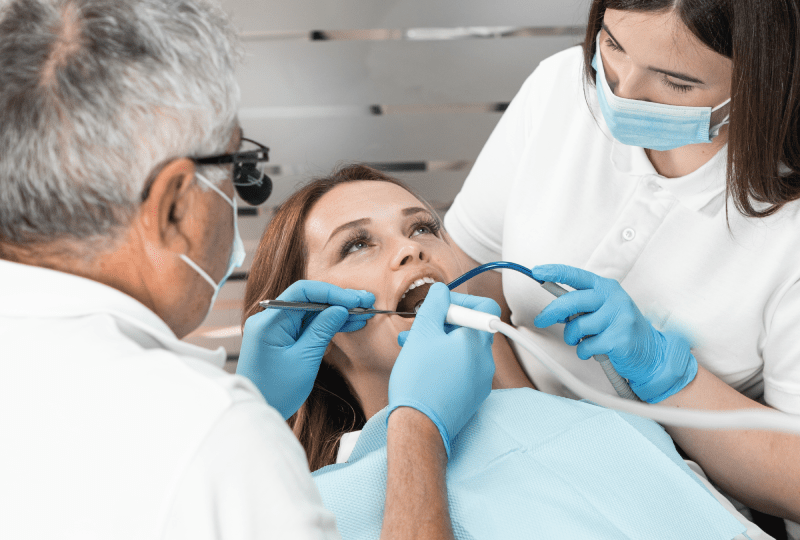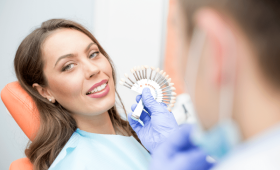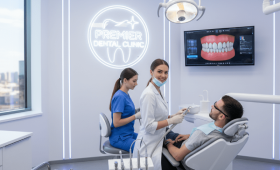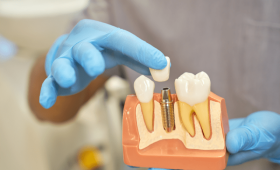What is All on 4 Treatment?
All on 4 is a prosthetic solution applied to patients who have lost all the teeth in a single jaw or whose teeth need to be extracted. In this method, four dental implants are placed at strategic points in the jawbone. These implants are specially designed to support a fixed full-arch prosthesis.
This allows patients to have both implants and temporary prosthetics in a single operation on the same day. This method can often be applied without the need for an additional bone grafting procedure, even in patients with early-stage bone resorption. It offers an ideal solution, especially for those with limited bone volume, and significantly shortens the treatment period.
What is All on 6 Treatment?
All on 6 treatment is a similar implant solution for full edentulism, but as the name suggests, it uses six implants. These additional two implants distribute the load on the prosthesis over a wider area, providing greater stability and durability. It is especially preferred in patients with sufficient jawbone volume and helps the prosthesis sit more firmly in the long term.
The All on 6 system provides stronger support, especially for the back teeth, making the chewing function more efficient. This method aims for patients to have a more secure and permanent tooth structure.
What is the Main Difference Between All on 4 and All on 6?
The main difference between these two methods is the number of implants used to support the prosthesis. All on 4 uses four implants, while All on 6 uses six implants. This increase in the number of implants allows the All on 6 treatment to provide more support and stability to the prosthesis.
All on 6 is more suitable for those seeking greater chewing force or who have sufficient jawbone. All on 4, on the other hand, offers the advantage of being applicable even in patients with less bone volume. This fundamental difference plays a key role in determining the most suitable treatment plan based on the patient’s individual needs and bone structure.
Who is All on 4 More Suitable For?
All on 4 treatment is an ideal option, especially for patients who have experienced significant bone loss in the lower and/or upper jaw but do not want to undergo a bone grafting procedure. Thanks to the strategic placement of four implants, the procedure can be performed while avoiding areas with limited bone volume.
This method provides results in a shorter time compared to traditional implant treatments and can be more cost-effective. Furthermore, the possibility of getting a prosthesis on the same day significantly improves the patient’s quality of life. Patients who are looking for a quick solution and want a minimally invasive operation can prefer this method.
Who is All on 6 an Ideal Option For?
All on 6 treatment is a more suitable alternative, especially for patients with a strong and healthy jawbone structure. With the extra support provided by six implants, the prosthesis sits more securely and withstands chewing forces better. This method is often preferred by patients seeking long-term durability and stability. All on 6 can extend the life of the prosthesis by providing a wider support area and offers better functionality, especially for the back teeth. Patients with a large bone volume who are looking for a permanent and reliable solution should choose this method.
How Long Does the All on 4 Procedure Take?
The surgical part of the All on 4 procedure is generally completed within one to two hours. One of the biggest advantages of the procedure is that a temporary prosthesis can be fitted on the same day after the implants are placed. This allows the patient to leave the clinic with their new teeth immediately after the operation.
However, the waiting period for the preparation of permanent prostheses can take several months, as the implants need to fuse with the bone. During this process, patients can continue their normal lives using their temporary prostheses. The total duration of the procedure may vary depending on the patient’s condition and any additional procedures to be performed.
How Long Does the All on 6 Procedure Take?
The surgical process for All on 6 may take a little longer than All on 4, but it is generally completed within two to three hours. Just like with All on 4, temporary prostheses can be fitted on the same day, allowing patients to immediately get an aesthetic and functional solution. Although the higher number of implants extends the surgical process slightly, this does not negatively affect the patient’s comfort. The waiting period required for the production and fitting of permanent prostheses can also take a few months, depending on the integration of the implants with the bone.
Is There Any Pain During the Procedure?
Both All on 4 and All on 6 operations are usually performed under local anesthesia, so no pain is felt during the procedure. If the patient is anxious or wants a more comfortable experience, sedation or general anesthesia options can also be considered. Post-operation, mild pain and swelling that can be controlled with painkillers recommended by the doctor are normal. This discomfort usually subsides within a few days. Working with a specialized dentist and their team ensures a comfortable experience during and after the procedure.
Which is Better for Patients with Bone Loss?
For patients with significant bone loss, All on 4 treatment is generally a better option. In this method, the implants are placed in the densest regions of the jawbone, that is, the front jaw and at 45-degree angles. This special placement usually eliminates the need for bone grafting. This means a less invasive procedure, a shorter treatment period, and a lower cost for patients. All on 6, on the other hand, is generally not suitable for patients with bone loss as it requires sufficient bone volume for more implant placement.
Why Are Implants Placed at Different Angles?
In both All on 4 and All on 6 treatments, implants are placed at strategic angles to best support the prosthesis. The front implants are placed at a right angle, while the back implants are positioned at a 45-degree angle. This angled placement allows for maximum use of the densest and strongest regions of the jawbone. At the same time, it minimizes the need for bone grafting and better distributes the load on the prosthesis. This technique ensures that the implants sit more securely and guarantees their long-term success.
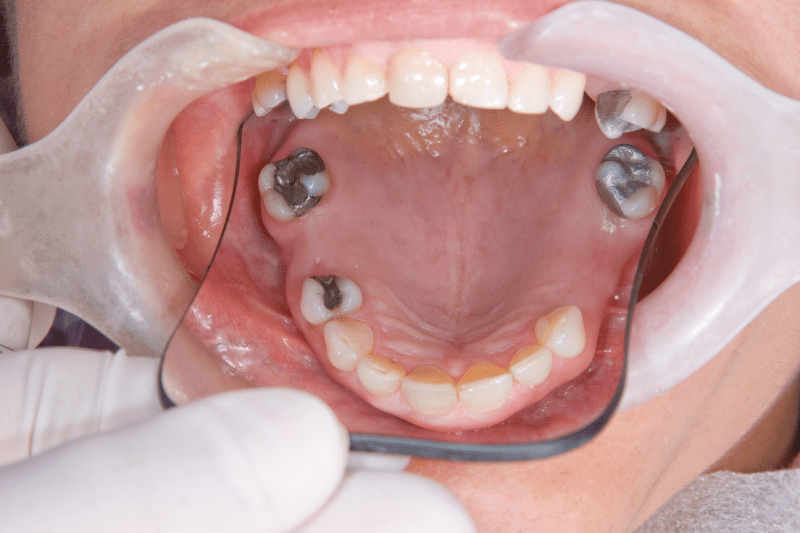
When Are the Prostheses Fitted?
In both All on 4 and All on 6 procedures, a temporary prosthesis known as a “same-day prosthesis” is fitted immediately after the surgical operation. These temporary prostheses allow the patient to return to their daily life immediately. The fitting of permanent prostheses takes place after the healing process required for the implants to fully fuse with the jawbone is completed, usually 3 to 6 months later. This waiting period is critical for the implants to become fully stable and for the permanent prostheses to achieve a perfect fit.
What Are the Success Rates?
The success rates of both All on 4 and All on 6 treatments are quite high, generally over 95%. However, these rates can vary depending on factors such as the patient’s general health, oral hygiene, and the experience of the dentist who performs the implant procedure. Regular check-ups and proper oral care guarantee the long-term success of the implants. Experienced, specialized dentists and clinics using modern technology are vital for increasing treatment success. We recommend working with reliable companies like Cure Holiday for your treatment success.
How Long Do the Implants Last?
All on 4 and All on 6 implants can last a lifetime with proper care and regular dental check-ups. The durability of the implants depends on the patient’s oral hygiene, habits like smoking and alcohol, and general health condition. High-quality implants can offer a lifetime warranty. However, the prostheses attached to the implants may need to be replaced after 10 to 15 years due to wear and tear. A routine of regular check-ups and good oral hygiene extends the life of both the implants and the prostheses.
What Should Care and Hygiene be Like?
The care for All on 4 and All on 6 implants is similar to that of natural teeth. Daily brushing, flossing, and mouthwash should be used to maintain regular oral hygiene. Special implant brushes and interdental brushes designed for under and around the prostheses can be used. Going for dental check-ups regularly every six months is vital to detect potential problems early and protect implant health. A good oral hygiene routine extends the life of the implants and prevents oral infections.
Why Are These Treatments Popular in Turkey?
Turkey has become a popular destination for implant treatments like All on 4 and All on 6. The main reasons for this include modern dental clinics offering high-quality services at Western standards, experienced dentists, and much more affordable costs compared to Western countries. Furthermore, patients who get treated in Turkey have the opportunity to combine the treatment process with a pleasant holiday experience. Companies like Cure Holiday organize the patient’s entire travel, accommodation, and treatment processes, making the treatment journey comfortable and stress-free.
What is the Cost of the Treatment?
The cost of All on 4 and All on 6 treatments can vary greatly depending on the quality of the implant and prosthesis materials used, the dentist’s experience, and the clinic where the procedure will be performed. All on 6 is generally more expensive than All on 4 due to the cost of the two additional implants. However, both treatments are more economical than getting single implants. In Turkey, these treatments are much more affordable than in Europe and North America. This allows many patients to receive quality treatment without straining their budget.
Why Does the Cost Difference Occur?
The cost difference between All on 4 and All on 6 is primarily due to the number of implants used. The six implants used in All on 6 require a higher material and labor cost compared to the four implants used in All on 4. Additionally, All on 6 treatment may require more surgical preparation and a longer operation time. Other factors such as the city where the clinic is located, the quality of the technology used, and the type of prosthesis material can also affect the total cost.
What Tests Are Performed Before Starting the Treatment?
Before starting the treatment, various tests are performed to examine the patient’s mouth and jaw structure in detail. These tests usually include a panoramic X-ray and a 3D jaw tomography (CBCT). These images allow the dentist to determine the volume, density, and location of the sinuses and nerves in the jawbone. This information is critical for planning where and at what angle the implants will be placed. A correct diagnosis and planning process are essential for the success of the treatment.
Which is Preferred for the Upper Jaw?
The upper jawbone can be generally softer and less dense than the lower jaw. Therefore, All on 4 may be more frequently preferred for patients experiencing bone loss in the upper jaw. However, for patients who have sufficient bone volume and are looking for a strong chewing force, All on 6 may be a better option. The dentist will evaluate your bone density and individual needs to determine the most suitable option for you. The sinuses in the upper jaw are also an important factor for implant placement and this should be taken into consideration by the dentist.
Which is Preferred for the Lower Jaw?
The lower jawbone is generally harder and denser, making it suitable for both All on 4 and All on 6. The choice of method depends on the patient’s bone volume and expectations. All on 6 is ideal when you want the prosthesis in the lower jaw to gain more stability. This extra support provides greater security and comfort, especially during chewing. However, All on 4 is also an effective and long-lasting solution for the lower jaw, especially in patients with limited bone volume.
Does Smoking Affect Treatment Success?
Yes, smoking can negatively affect the success of both All on 4 and All on 6 treatments. Smoking reduces blood flow in the mouth, slowing down the process of osseointegration (fusion of implants with the bone) and increasing the risk of infection. Therefore, dentists generally recommend that patients avoid smoking for a certain period before and after the implant operation. Smoking not only jeopardizes the healing process but also the long-term health of the implants.
Can Diabetic Patients Have This Treatment?
Patients with controlled diabetes can generally undergo All on 4 and All on 6 implant treatments. However, it is very important that diabetes is under control, as high blood sugar levels can slow down the healing process and increase the risk of infection. Before starting the treatment, the patient’s blood sugar levels should be stabilized, and the dentist and internal medicine specialist should work together. Diabetic patients need to pay more attention to oral hygiene and go for regular check-ups.
How Many Stages Does the Treatment Process Consist Of?
All on 4 and All on 6 treatment usually consists of three main stages. The first stage is the surgical placement of the implants and the fitting of temporary prostheses on the same day. The second stage is the healing process required for the implants to fully fuse with the bone, and this process usually takes 3 to 6 months. The third and final stage is taking the measurements for and fitting the permanent prostheses after the implants are fully stabilized. This phased approach guarantees both surgical success and long-term aesthetic and functional results.
Is This Procedure Reversible?
All on 4 and All on 6 implant treatments are permanent solutions and are considered irreversible procedures. Implants are surgically placed into the jawbone and are fixed by fusing with the bone. Therefore, it is very important for patients to be sure of their decision and to discuss all possibilities with their dentist before starting the treatment. With proper planning and a successful operation, these implants offer a permanent and reliable solution for a lifetime.
How Do Temporary Teeth Look and Feel?
The temporary prostheses fitted in All on 4 and All on 6 treatments are aesthetically very similar to permanent prostheses and allow patients to smile with confidence. Functionally, they also enable patients to return to their normal speech and chewing activities. However, these prostheses are made of temporary materials, so they should be used more carefully. The dentist will provide detailed instructions on how to use the temporary prostheses. These prostheses provide comfort and aesthetics during the healing process.
What Should Be Paid Attention to After the Procedure?
After the implant operation, it is crucial for patients to follow the doctor’s instructions. In the first 24 hours, it is important to avoid hard foods, smoking, and alcohol, and to avoid harsh brushing that could cause bleeding in the mouth.
Mild swelling and pain are normal in the first few days and can be controlled with ice packs and painkillers. Paying attention to oral hygiene and using the special mouthwashes given by the doctor reduces the risk of infection. Attending regular follow-up appointments is also necessary for the healing process.
When Do Eating Habits Return to Normal?
Patients can start eating soft foods with the temporary prostheses fitted immediately after All on 4 and All on 6 treatment. Hard and sticky foods should be avoided for the first few months. After full healing and the fitting of permanent prostheses, patients can return to their normal eating habits. Permanent prostheses are designed to withstand strong chewing forces just like natural teeth.

Do the Aesthetic Results Meet Expectations?
All on 4 and All on 6 treatments offer extremely natural and aesthetic results. The dentist designs and produces the prostheses to suit the patient’s facial structure and oral anatomy. The color, shape, and size of the prostheses are adjusted to mimic the appearance of natural teeth. This way, patients achieve results that are satisfying not only functionally but also aesthetically. Having a confident smile significantly increases the patient’s quality of social life.
How Is the Appointment and Accommodation Process Managed?
For patients considering treatment in Turkey, the appointment and accommodation process can be easily managed by professional service providers like Cure Holiday. These companies organize the patient’s travel schedule, accommodation needs, and clinic appointments. Airport transfers and guidance services are offered throughout the treatment period. This allows patients to focus on the treatment process and complete their experience in Turkey without stress. Cure Holiday plans the entire process for you from start to finish.
What Are the Additional Costs Besides the Treatment Price?
In addition to the total cost of All on 4 and All on 6 treatment, expenses such as travel, accommodation, and food are also added. However, these additional costs in Turkey are generally lower than in other countries. Additionally, in rare cases, extra surgical procedures or special tests may be required. Companies like Cure Holiday offer transparent pricing for patients, preventing surprise costs and helping you plan the treatment process from start to finish.
Who Should Perform the Treatment?
All on 4 and All on 6 treatments should be performed by experienced dentists and surgeons specialized in this field. The correct placement of implants is vital for the success of the treatment. It is important for patients to choose clinics that have successfully performed these procedures before and have references. Therefore, by working with reliable companies like Cure Holiday, you can gain access to specialized dentists in the field.
What is the Effect of Implants on the Jawbone Structure?
All on 4 and All on 6 implants help prevent bone resorption by stimulating the jawbone. Just like the roots of natural teeth, implants apply force to the jawbone, keeping the bone healthy. This way, they help preserve the facial structure in the long term and prevent bone loss that can occur with aging. This shows that implant treatment is an important investment not only from an aesthetic but also from a health perspective.
Are There Different Prosthesis Options Available?
The prostheses used in both All on 4 and All on 6 treatments can be fixed (screwed) or hybrid (both fixed and removable). Fixed prostheses are screwed onto the implants and can only be removed by a dentist. These prostheses feel the most natural. Hybrid prostheses are lighter and more economical. The decision on which prosthesis is more suitable is made by the dentist, taking into account factors such as the patient’s preferences, budget, and bone structure.
What Should I Do Before Making an Appointment?
If you are considering All on 4 or All on 6 treatment in Turkey, your first step should be to do detailed research. By contacting a reliable consultancy firm like Cure Holiday, you can get information about experienced dentists and clinics, and get preliminary information about the treatment plan and costs. You can get a preliminary evaluation by sharing your jaw X-ray or 3D tomography. This preparation will make your treatment process more planned and smooth.
What Age Group Are All on 4 and All on 6 Suitable For?
All on 4 and All on 6 treatments are generally suitable for adults. There is no upper age limit for these treatments, but the patient’s general health condition must be suitable for the surgical procedure. Since the jawbone needs to complete its development, it is not suitable for young patients. The most suitable candidates are individuals who have lost all their teeth or whose remaining teeth need to be extracted, and who are in good general health.
What is the Prosthesis Material in All on 4 and All on 6 Treatment?
The prostheses used in All on 4 and All on 6 treatments are generally made of high-quality materials such as zirconium, acrylic, or porcelain. Zirconium is known to be the most natural-looking and durable material, so it is often preferred when aesthetic results are most important. Acrylic prostheses are more economical but less durable. The material choice is determined based on the patient’s budget, expectations, and the dentist’s recommendation.
Why Are Temporary Prostheses Important?
Temporary prostheses are of great importance both aesthetically and functionally during the healing process. Thanks to these prostheses, patients can eat, speak, and smile normally until their permanent teeth are fitted. They also help the healing process by reducing the pressure on the implants.
Why Should You Choose Turkey for All on 4 and All on 6 Treatment?
Turkey offers world-class service for implant treatments like All on 4 and All on 6. When experienced dentists, state-of-the-art equipment, and affordable prices come together, it offers an excellent option for patients. The opportunity to combine the treatment with a holiday is a bonus. By working with a professional partner like Cure Holiday, you can turn your treatment process into a smooth and enjoyable experience.
What Preparations Are Made Before the Treatment?
Before starting the treatment, the dentist evaluates the patient’s general health condition, oral hygiene, and any chronic diseases. Necessary tests and X-rays are taken. The patient is informed about the need to refrain from habits like smoking and alcohol before and after the operation. Detailed information is given about the stages of the treatment and the healing process. This process is vital for the success of the treatment and begins with proper planning.
What Type of Anesthesia is Used in the Treatment?
All on 4 and All on 6 operations are generally performed under local anesthesia. This means only the area to be operated on is numbed, and the patient remains awake throughout the procedure. However, sedation or general anesthesia can also be applied depending on the dentist’s and patient’s preference. Sedation makes the patient feel more relaxed and drowsy, while general anesthesia puts them completely to sleep. These options are offered to maximize the patient’s comfort.
How to Clean All on 4 and All on 6 Teeth?
To clean these types of prostheses, specially designed implant brushes, interdental brushes, and water flossers should be used. The areas where the prosthesis and implants meet require special attention to prevent bacterial buildup. The dentist will give you detailed information on the most suitable cleaning methods for you. Regular and correct cleaning ensures the long life of the implants and protects oral health.
